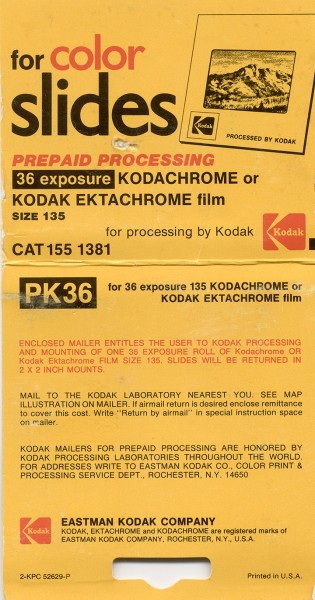 It’s getting time for me to head back to Cape, so Wife Lila has been stuffing my clothes in a suitcase so they are ready to go. That means that when I went to the sock and underwear drawers this morning, I could see all the way to the bottom.
It’s getting time for me to head back to Cape, so Wife Lila has been stuffing my clothes in a suitcase so they are ready to go. That means that when I went to the sock and underwear drawers this morning, I could see all the way to the bottom.
Now, the bottom of my sock and underwear drawers are the swamps where I hope dinosaur memories will go to turn into diamonds under a combination of pressure and the passage of time.
Souvenirs, cards from friends and family, Boy Scout badges, my old high school medals, the Richard Nixon cufflinks, the Cross pen and pencil set I got for 10 years of service at The Palm Beach Post, some Steinhoff, Kirkwood and Joiner wooden pencils, Old Maid playing cards from grade school days…. all sink to the bottom. Things get shuffled enough that their ages could be determined by carbon dating, but they wouldn’t necessarily be stratified in date order.
Back in the back of the back, hiding under a baseball autographed by a bunch of guys who might or might not be famous, was a stack of Kodachrome prepaid mailers that I bought when I was photographing the last days of Trinity Lutheran Church in 1978.
Kodachrome introduced in 1935
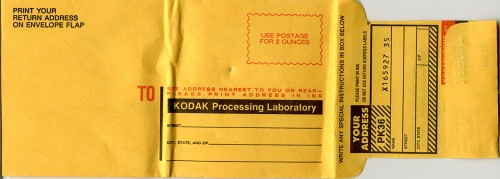 Eastman Kodak introduced the color reversal film Kodachrome in 1935. “Color reversal” meant the end product was a positive image that could be projected rather than a negative that had to be reversed in the printing process.
Eastman Kodak introduced the color reversal film Kodachrome in 1935. “Color reversal” meant the end product was a positive image that could be projected rather than a negative that had to be reversed in the printing process.
Kodachrome was produced as 16mm film at first, but branched out in other sizes over the years. Our 8mm home movies were shot on Kodachrome and lots of my early 35mm slides were on that brand. Until GAF bought the company, even my Viewmaster slides were Kodachrome.
Required special processing
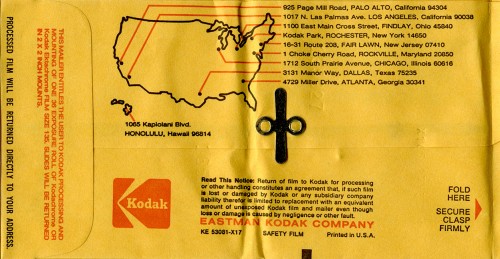 Unlike black and white film and Ektachrome, which could be processed in a home darkroom (or even in the back of a small airplane), Kodachrome had to be sent off so one of a handful of special labs
Unlike black and white film and Ektachrome, which could be processed in a home darkroom (or even in the back of a small airplane), Kodachrome had to be sent off so one of a handful of special labs
The closest one to Cape was in Chicago.
Unfortunately, demand for Kodachrome died off with the popularity of Ektachrome and Fujichrome E6 films. Digital photography killed it off completely. On July 14, 2010, the last roll of Kodachrome was processed for Steve McCurry, on assignment for National Geographic. It was a 74-year run.
Even black and white was sent away
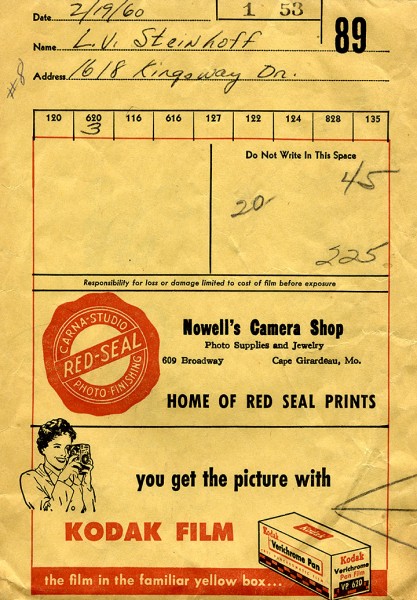 When Dad took in some of my film from our big 1960 vacation trip to Florida for processing, Nowell’s Camera Shop shipped the rolls off.
When Dad took in some of my film from our big 1960 vacation trip to Florida for processing, Nowell’s Camera Shop shipped the rolls off.
Here’s something that you youngsters who are sexting on your smartphones won’t encounter: Kodak was pretty prudish. If you sent them any pictures that were the least bit racy, they not only wouldn’t return them; they might even turn them over to the cops or the postal authorities who would come to chat with you.
Because of that, we photographers on the university newspaper and yearbook would sometimes be approached to do some discrete processing for some guy who didn’t want to send his “art” off to Kodak.
After my first freelance processing job, I saw why the other guys would turn down that business. We weren’t afraid of getting caught: it just wasn’t worth the hassle. Hormonally hindered guys who aren’t real photographers would bring in horribly underexposed, blurry pictures that might be of their girlfriend or a water buffalo. Then, when you couldn’t pull anything recognizable off the film, they’d refuse to pay up. We would suggest they go uptown and buy a cheap Polaroid if they planned to ever do that kind of photography again.
Black & white only went to St. Louis
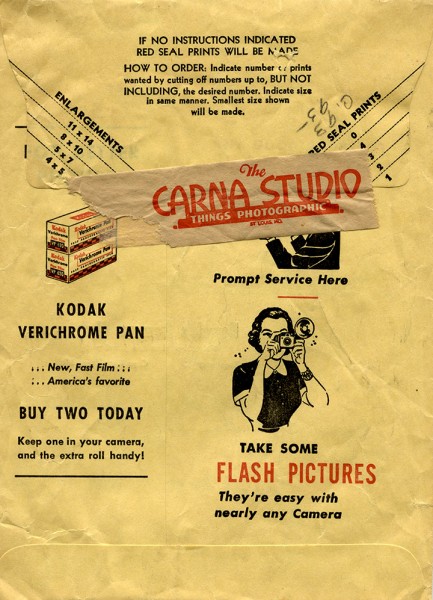 A piece of tape on the back of the processing envelope said my film had been sent to The Carna Studio in St. Louis. Cape probably didn’t generate enough processing business for Bill Nowell to invest in the kind of equipment it would take to automate the process and to carve out enough space in the store to set it up.
A piece of tape on the back of the processing envelope said my film had been sent to The Carna Studio in St. Louis. Cape probably didn’t generate enough processing business for Bill Nowell to invest in the kind of equipment it would take to automate the process and to carve out enough space in the store to set it up.
On top of that, keeping the chemicals balanced is difficult if you don’t run a large volume of film through it. I was pleased when a Kodak rep who looked at the calibration strips at we ran at The Post said that our results were better than a commercial lab in town, probably because we processed more film per day than they did and (I like to think) our lab techs were better trained and more motivated.
So, if Kodachrome ever comes back, I’m ready with my envelopes.

The was giant place in De Sota Mo. that developed pictures…they have billboards on the highway all over the place…and I can not remember them. I used to take my stuff to Nowell’s for developing too…I never new they sent the stuff out! One more thing I learned from your blog!
it was FOJO Photo as I remember
Well I left Cape in good shape for you. All the snow is gone but there is still some standing water in places but that should be gone by the time you get there. I am between Nashville and Chattanooga at exit 110 I believe at Prather’s BBQ having lunch. You may want to try it as it seems to be your kind of place, cheap and good food.
Am I going to be able to use the heated seats in my new van?
Ken, my husband still has some mailers around – just in case they return!! He used those mailers until they no longer would process. Te place in DeSoto, NO was Fo-Jo. I sent many rolls here when I lived in MO. I think maybe even when we were in southern Florida.
After WW II my Dad bought a camera that took slides and he would send the roll away to be developed. We could hardly wait to get out the projector to see them when they came back. Still have lots of slides and not too long ago got out the old projector and sat and went through years of slides. Brought back many memories. He kept track of each picture he took with all the information of settings he used and then wrote the info on the back of the slide.
Terry, It was FoJo studios in Desoto, Missouri.
Those billboards were all over Indiana where I grew up.
I hadn’t heard FoJo mentioned in years. Looks like there is still a Fo-Jo Studio in DeSoto, but I don’t know if it has any connection to the place that did processing.
Still cool in the morning. So I would think so. Enjoy them.